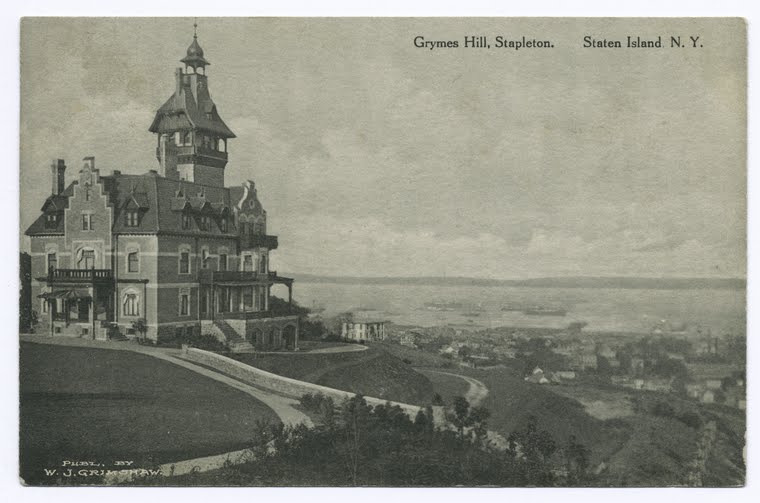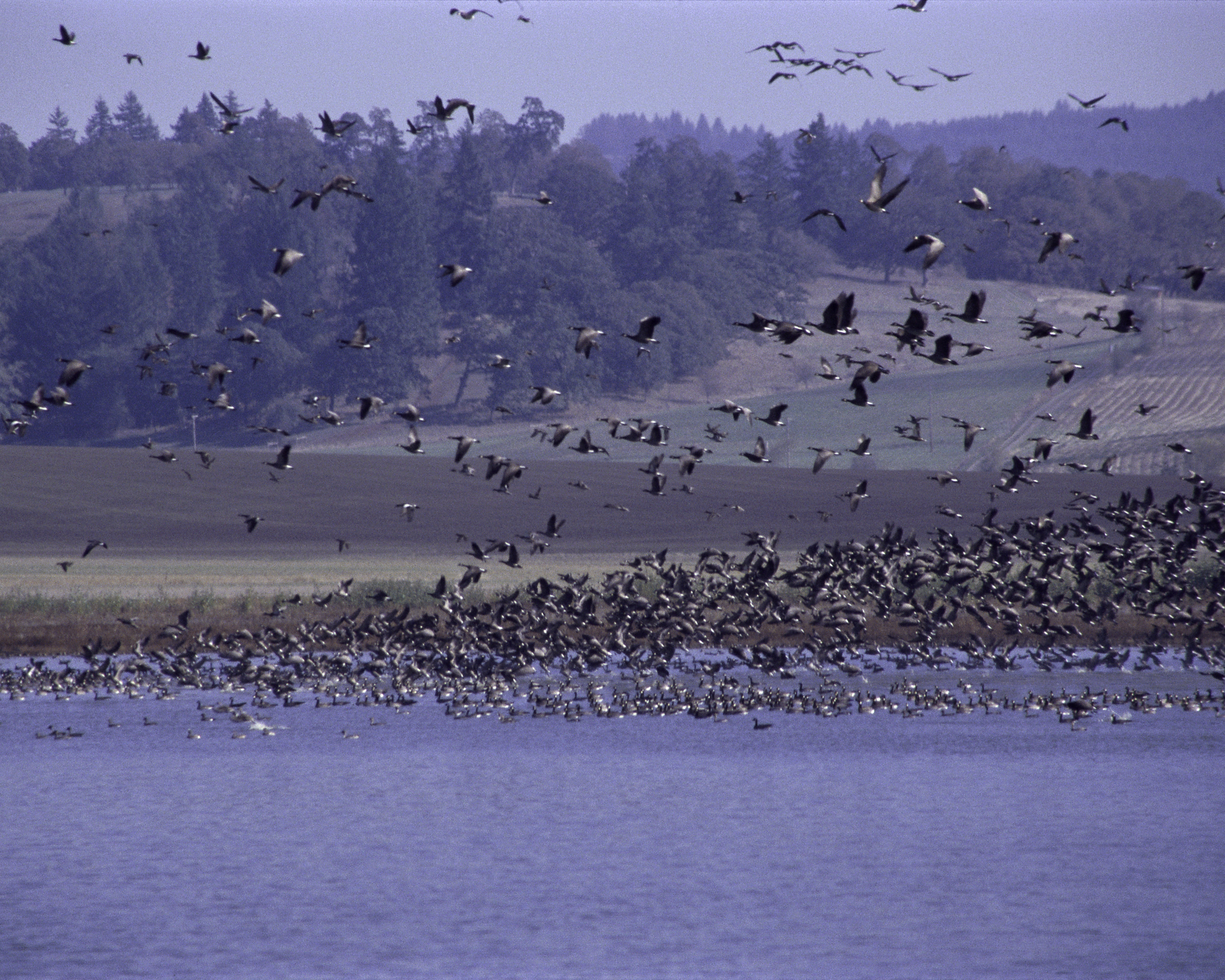|
Serpentine Art And Nature Commons
The Serpentine Art and Nature Commons ("SANC" or "Serpentine Commons") is a not-for-profit organization founded in 1978. SANC is dedicated to preserving and maintaining the woodlands and serpentine ridge on the east shore of Staten Island and more specifically within the neighborhoods of Grymes Hill and Silver Lake. The Serpentine Commons is a community-based group that provides open space, hikes and other educational opportunities to the North Shore of Staten Island on the more than 10 acres of the approximately 40 acres of land in the Serpentine Ridge Nature Preserve of the Special Hillsides Preservation District. SANC owns the four lots comprising the over 10 acres of land thanks to a grant by the Trust for Public Land. The steep slope park is open to everyone without charge. The hiking trails start at the bottom of the hill at 599 Van Duzer Street. There is also an entrance from the top of the hill at 255 Howard Avenue as well as a gated entrance by 30 Howard Circle. The ... [...More Info...] [...Related Items...] OR: [Wikipedia] [Google] [Baidu] |
Staten Island
Staten Island ( ) is a borough of New York City, coextensive with Richmond County, in the U.S. state of New York. Located in the city's southwest portion, the borough is separated from New Jersey by the Arthur Kill and the Kill Van Kull and from the rest of New York by New York Bay. With a population of 495,747 in the 2020 Census, Staten Island is the least populated borough but the third largest in land area at . A home to the Lenape indigenous people, the island was settled by Dutch colonists in the 17th century. It was one of the 12 original counties of New York state. Staten Island was consolidated with New York City in 1898. It was formally known as the Borough of Richmond until 1975, when its name was changed to Borough of Staten Island. Staten Island has sometimes been called "the forgotten borough" by inhabitants who feel neglected by the city government. The North Shore—especially the neighborhoods of St. George, Tompkinsville, Clifton, and Stapleton—i ... [...More Info...] [...Related Items...] OR: [Wikipedia] [Google] [Baidu] |
Grymes Hill, Staten Island
Grymes Hill is a tall hill formed of serpentine rock on Staten Island, New York. It is the second highest natural point on the island and in the five boroughs of New York City. The neighborhood of the same name encompasses an area of and has a population of 8,263 people. The hill also includes parts of the Silver Lake neighborhood. The area includes part of ZIP Codes 10301 and 10304. Etymology The hill is named after Suzette Grymes, wife of prominent New Orleans lawyer and member of the First Families of Virginia, John Randolph Grymes. Her first husband was the first governor of Louisiana, William Charles Cole Claiborne. She settled on Staten Island in 1836. Geography Neighborhoods around Grymes Hill include Ward Hill to the north, Silver Lake to the west, Sunnyside and Emerson Hill to the south, to the southeast is Concord, and Stapleton and Stapleton Heights to the east. The east side of the hill is defined by Van Duzer Street and Richmond Road to the intersection w ... [...More Info...] [...Related Items...] OR: [Wikipedia] [Google] [Baidu] |
Silver Lake, Staten Island
Silver Lake is the name of both a reservoir and an adjacent neighborhood in the New York City borough of Staten Island. History Silver Lake Park, located on Staten Island's north shore, is bounded by Forest Avenue, Victory Boulevard and Clove Road. The original Silver Lake was a spring-fed body of water formed at the end of the ice age, and now makes up the south basin of the reservoir at this site. Silver Lake was once known as Fresh Pond, but maps show that by the middle of the nineteenth century, the name Silver Lake had come into use and the two were used interchangeably until about 1860. Silver Lake was named after Mark Silver, who founded the philanthropic organization today known as the Hebrew Free Burial Association. He had earlier Americanized his name from Marks Silva. The Association purchased land that became the Silver Lake Cemetery, and it was used for charitable burials. Many of the victims of the 1911 Triangle Shirtwaist Factory fire are buried there. Silver Lake ... [...More Info...] [...Related Items...] OR: [Wikipedia] [Google] [Baidu] |
North Shore, Staten Island
The term North Shore is frequently applied to a series of neighborhoods within the New York City borough of Staten Island. Boundaries Generally, the North Shore is deemed to include the communities located within ZIP codes 10303, 10302 and 10310 in their entirety, along with all of the area covered by 10301 except Sunnyside, and those parts of 10304, 10305, 10314 that lie north of the Staten Island Expressway. This definition includes Mariners Harbor, Port Richmond, Westerleigh, Meiers Corners, Graniteville, Castleton Corners, West Brighton, New Brighton, St. George, Tompkinsville, Stapleton, Grymes Hill, Park Hill, Clifton, and Rosebank among the North Shore's neighborhoods. The Staten Island Expressway is considered by many to be a southern border. History The North Shore is Staten Island's oldest and most densely populated area. Archaeological evidence found along its waterfront tells us that the Leni Lenape (common people) Indian Tribe established a settleme ... [...More Info...] [...Related Items...] OR: [Wikipedia] [Google] [Baidu] |
Serpentine Ridge Nature Preserve
The Serpentine Ridge Nature Preserve is a 40 acres woodland in the North Shore of Staten Island between Howard Avenue at the top of the ridge and Van Duzer Street at the bottom of the hill. The Serpentine Ridge plays an important part in Staten Island's ecosystem and biodiversity and maintains significant geological features. The Serpentine Ridge is a steep terrain on the east shore of the island within the Grymes Hill and Silver Lake neighborhoods of Staten Island. The area is notable for its variety of ecosystems including wooded hillsides, glacial sinkholes, and bare serpentine rock. The area is part of Staten Island's Special Hillsides Preservation District. The district was established to preserve the hilly terrain and unique natural features of the region, by reducing hillside erosion, landslides, and excessive storm-water runoff. Most of its land remains in a natural state, thus the area is covered with native vegetation. The Serpentine Art and Nature Commons owns approximate ... [...More Info...] [...Related Items...] OR: [Wikipedia] [Google] [Baidu] |
Special Hillsides Preservation District
The Special Hillsides Preservation District was created in 1987 by the City of New York to preserve the hilly terrains of the North Shore of Staten Island. The district maintains different planning rules to the rest of the City to account for the geological and bio diversity of the area. The district's goals are to reduce hillside erosion, landslides, and excessive storm-water runoff by conserving vegetation and protecting natural terrain; preserve hillsides with unique aesthetic value; protect areas of outstanding natural beauty; and protect neighborhood character. The district is under the Staten Island Community Board 1 supervision and it affects the green areas in the following Staten Island neighborhoods: Grymes Hill, New Brighton, Randall Manor Randall Manor is a neighborhood on the North Shore of Staten Island, one of the five boroughs of New York City, United States. The neighborhood is bound by Bard Avenue to the West, Henderson Avenue to the North, Forest Avenue to ... [...More Info...] [...Related Items...] OR: [Wikipedia] [Google] [Baidu] |
The Trust For Public Land
The Trust for Public Land is a U.S. nonprofit organization with a mission to "create parks and protect land for people, ensuring healthy, livable communities for generations to come". Since its founding in 1972, the Trust for Public Land has completed 5,000 park-creation and land conservation projects across the United States, protected over 3 million acres, and helped pass more than 500 ballot measures—creating $70 billion in voter-approved public funding for parks and open spaces. The Trust for Public Land also researches and publishes authoritative data about parks, open space, conservation finance, and urban climate change adaptation. Headquartered in San Francisco, the organization is among the largest U.S. conservation nonprofits, with approximately 30 field offices across the U.S., including a federal affairs function in Washington, D.C. Focus areas Consistent with its "Land for People" mission, the Trust for Public Land is widely known for urban conservation work, inclu ... [...More Info...] [...Related Items...] OR: [Wikipedia] [Google] [Baidu] |
Wagner College
Wagner College is a private liberal arts college in Staten Island, New York City. Founded in 1883 and with an enrollment of approximately 2,200 students, Wagner is known for its academic program, The Wagner Plan for the Practical Liberal Arts. It is accredited by the Middle States Commission on Higher Education. History Wagner College was founded in 1883 in Rochester, New York, as the Lutheran Proseminary of Rochester. Its purpose was to prepare young men for admission to Lutheran seminaries and to ensure that they were sufficiently fluent in both English and German to minister to the large German immigrant community of that day. The school's six-year curriculum (covering the high-school and junior-college years) was modeled on the German ''gymnasium'' curriculum. In 1886, the school was renamed Wagner Memorial Lutheran College, after a building in Rochester was purchased for its use by John G. Wagner in memory of his son. The college moved to the 38-acre (15 ha) former Cunard ... [...More Info...] [...Related Items...] OR: [Wikipedia] [Google] [Baidu] |
Wildlife Conservation
Wildlife conservation refers to the practice of protecting wild species and their habitats in order to maintain healthy wildlife species or populations and to restore, protect or enhance natural ecosystems. Major threats to wildlife include habitat destruction, degradation, fragmentation, overexploitation, poaching, pollution and climate change. The IUCN estimates that 27,000 species of the ones assessed are at risk for extinction. Expanding to all existing species, a 2019 UN report on biodiversity put this estimate even higher at a million species. It is also being acknowledged that an increasing number of ecosystems on Earth containing endangered species are disappearing. To address these issues, there have been both national and international governmental efforts to preserve Earth's wildlife. Prominent conservation agreements include the 1973 Convention on International Trade in Endangered Species of Wild Fauna and Flora (CITES) and the 1992 Convention on Biological Diversity (C ... [...More Info...] [...Related Items...] OR: [Wikipedia] [Google] [Baidu] |



